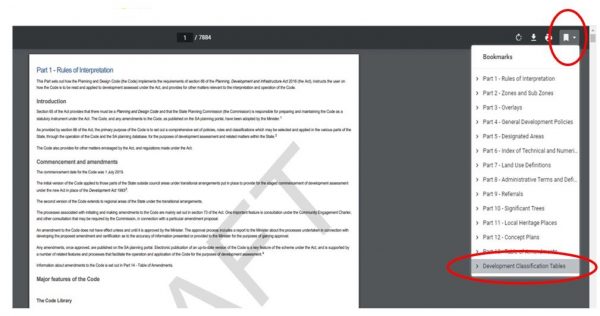De—coding Phase 3 of the Planning and Design Code — Paper 2 — Shops, Restaurants and Other Commercial Uses
30 November 2020
This is Paper 2 of 4 in our series on the amended Draft Phase 3 Planning and Design Code (“draft Code”) and accompanying Phase Three (Urban Areas) Planning and Design Code Amendment Summary of Post-Consultation Amendments November 2020 report (“the report”).
Consultation on the amended Code remains open until 18 December 2020.
Please be advised that the .pdf version of the Code can be accessed through this link and now contains all Development Classification Tables at the end of the Code, which Tables can be accessed through bookmarks as below.

Further, the Code review function “What policies apply to a development” as depicted below as of the date of this Paper, lists accepted and deemed-to-satisfy pathways for developments.

Lastly, when considering restricted forms of development, it should be remembered that:
- the State Commission Assessment Panel is the decision-maker for restricted forms of development;
- there is no right of concurrence for Council Assessment Panels, Regional Assessment Panels or Assessment Managers;
- representors for restricted forms of development have appeal rights against final decisions made by the SCAP on restricted development applications;
- appeal rights for applicants are prevented for ‘early refusal’ decisions on their applications. Final decisions are able to be appealed and this needs to be considered when making submissions on whether forms of development should be listed as restricted or not.
This paper concerns shops, restaurants and other commercial uses, a topic that has given rise to many appeals and reviews in the ERD Court and the Supreme Court over recent years, due to the ever-evolving nature of these uses.
Shops, restaurants and other commercial uses in residential areas
These forms of development can cause much controversy, particularly where there is limited to no off-street parking provision, where surrounding residential streets are narrow and/or where amenity impacts such as noise and odour arise.
Shops (including restaurants) and other commercial uses in all forms of Neighbourhood Zones are performance-assessed developments, meaning that they are assessed on their merits against the relevant provisions of the Code.
These forms of development are subject to public notification only where they do not meet ‘appropriate’ limits on their size and their design. The ‘appropriate’ limits are, with a few exceptions, generally similar between all forms of Neighbourhood Zones (except the Urban Neighbourhood Zone) and require that the proposed development:
1. reinstates a former shop, consulting room or office;
2. is ancillary to and located on the same allotment as a dwelling and does not exceed 50m2 gross leasable floor area or 30% of the floor area of the associated dwelling (excluding any garage or carport), whichever is the lesser;
3. is located more than 500m from an Activity Centre and:
3.1 does not exceed 100m2 gross leasable floor area (in a single building)
3.2 does not exceed 200m2 gross leasable floor area (in a single building) where the site has a street frontage to a State Maintained Road
4. complies with height limits imposed in the relevant Zone; and
5. does not involve the demolition of a State or Local Heritage Place.
Councils may wish to consider whether there are particular areas within each Neighbourhood Zone where ‘tighter’ notification requirements should apply and, if so, whether a Subzone should be proposed.
In all of the Neighbourhood Zones (except the Urban Neighbourhood Zone), shops (except restaurants) with a gross leasable floor area of 1,000m2 or more are ‘restricted’ forms of development. This means that development applications proposing such forms of development are determined by the State Commission Assessment Panel (“SCAP”), are subject to full public notification, representors have appeal rights on decisions made by the SCAP and applicant appeal rights are limited.
Councils may wish to consider whether there are areas proposed to be zoned within a form of Residential Zone where the forms of shops and other uses which are ‘restricted’ forms of development, should be expanded and, if so, whether a Subzone or Overlay should be proposed.
Shops, restaurants and other commercial uses in non-residential zones
In each of the forms of Main Street Zones and Activity Centre Zones changes in land use to:
- shop (other than where the shop is a restaurant or otherwise involves the handling and sale of foodstuffs or the heating and cooking of foodstuffs in a commercial kitchen);
- office; and
- consulting room
are provided with ‘accepted development’ assessment pathways, provided that criteria related to gross leasable floor area, vehicle access and off-street car parking, are met.
‘Accepted development’ does not require a planning consent. All that is required for these forms of development is, where applicable, a building consent.
This is the first time that such forms of development have been provided with an assessment pathway that avoids the need for any form of planning assessment to take place.
Each of these Zones also provides broad, deemed-to-satisfy criteria for changes in land use generally as well as for shops (including restaurants). Deemed-to-satisfy development does not undergo public notification, is subject to codified ‘tick and flick’ planning assessment and can be approved by accredited professionals (previously known as private certifiers).
All changes in land use in these Zones which are not on land contained within a State Heritage Area Overlay or a State Heritage Place Overlay and which meet Land Use and Intensity DTS/DPF 1.7 are deemed-to-satisfy. DTS/DPF 1.7 contains a number of provisions which are intended to avoid noise and odour nuisances from restaurants and food businesses. For shops (including restaurants) specifically, they must also meet that certain additional traffic, parking and access provisions of the Code are met.
Councils should consider whether the criteria for accepted and deemed-to-satisfy developments and the extent of the relevant Zones are appropriate and whether these factors should be widened or narrowed.
Again, we encourage all councils to carefully consider and review these documents as the Code amendments will apply across the State and there are a number of new Zones and policies which are intended to address and/or clarify Phase 2 policy anomalies and/or omissions.
For further information regarding the draft Code, please contact:
Victoria Shute: vshute@kelledyjones.com.au
David Altmann: answers@developmentanswers.com.au

LINKS TO PAST PAPERS:

